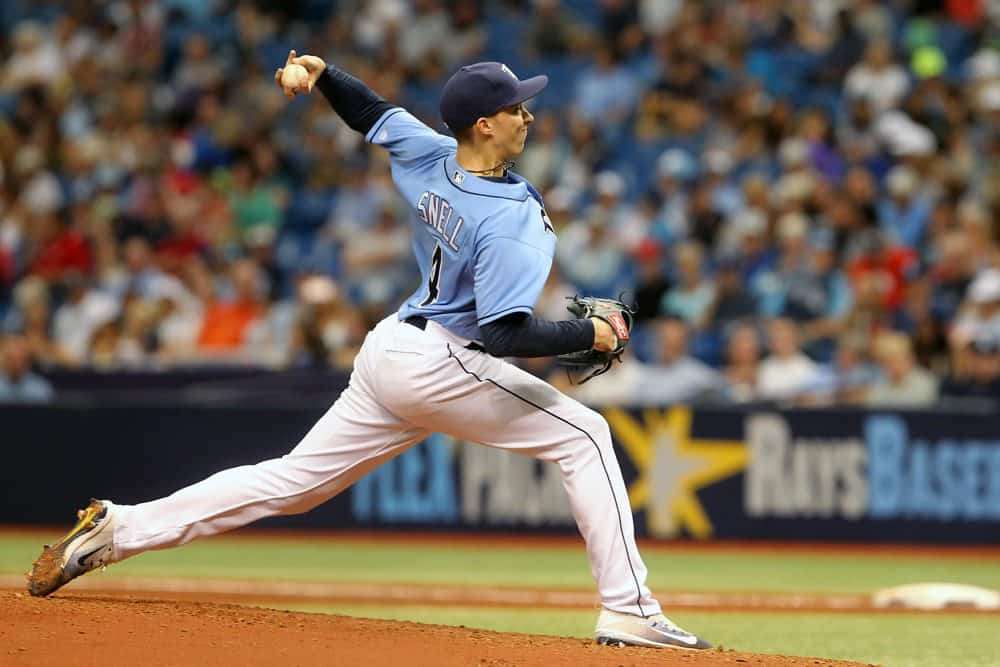
Chasing the sexy young pitcher rarely works out in preseason drafts, and many can add Blake Snell to the list. After winning six games in 2016 with 98 strikeouts and a 3.54 ERA, many overlooked the walk percentage when targeting Snell. His low ERA and high strikeouts come with a cost, especially to a team’s key ratio statistic: WHIP. Snell’s 1.62 mark last year did not go away when he returned to Triple-A in June.
Since his return, things seem to be looking up. In the second half, Snell’s lowered his ERA (3.86), FIP (3.92) and WHIP (1.18) with a very respectable 14.1 strikeout minus walk percentage. It all looks nice, but can a fantasy owner trust Snell with head-to-head playoffs looming or for the stretch run in rotisserie leagues?
1. Injuries could force one’s hand
Suggesting injuries moved to the forefront of why some teams remain in contention while others swooned seems trite. Also, with Max Scherzer landing on the disabled list, the three consensus pitchers, according to average draft position, spent time on the shelf this year with Scherzer and Clayton Kershaw still on it. Owners on the verge of moves limits or needing a fresh arm on the roster could do worse than Snell.
In August, he’s turned in a better WHIP and strikeout minus walk percentage than Aaron Nola or Alex Wood. On the surface, his two wins and 4.42 ERA do not cry grab him from the waiver wire, but delving deeper could provide more clarity.
2. Month by month improvement
[the_ad id=”384″]Things seemed to start on the right path for Snell when he finished April with a 3.42 ERA, but warning signs hid well behind the numbers. His FIP of 5.30, along with the same number of strikeouts and walks (18), rang the alarms of regression to come. And, boy did it. Snell’s ERA in May grew to 6.89, and he allowed six runs in his only five innings of work in June prior to his demotion.
After his first three months, Snell’s 40 strikeouts compared to 30 walks did not provide much hope for a rebound. However, Snell went to the minors and improved. Over his 21.1 innings in July, Snell struck out 19 against 10 walks with a 3.80 ERA and 1.36 WHIP. Not eye-popping numbers, but progress.
August’s been ever better to Snell. He won his first start since September of last year on August 15th and then for the first time in consecutive starts for his career on Sunday. Snell’s made three straight starts with at least six innings pitched. It’s difficult to win a game when working five innings or less due to a high pitch count with the propensity to walk too many batters. This harpooned Snell’s early-season production.
3. Snell’s surging
Not only did Snell win back-to-back starts his last two times on the mound, he’s allowed two or fewer walks in six straight starts, including a 3.42 ERA over his last eight outings. After struggling in the first half, Snell’s turned things around with a 3.86 ERA in 39.2 innings since the break with 35 strikeouts, 12 walks and a very respectable 1.18 WHIP. Again, progress. Numbers can be deceiving, so what’s fueled the recent improvement?
4. Snell’s curve is back?
While spotty command hindered Snell in the first half and led to his demotion, an improved strikeout minus walk percentage, along with a better FIP and WHIP, seem to be trending Snell in the right direction. For starters, keeping his fastball in or near the strike zone will only help his off-speed pitches. Batters hit only .248 against his fastball, but if it’s not in the zone, they lay off and take the walk. Scouting reports drive this.
But, Snell’s using his fastball better in August, throwing it almost 51 percent of the time. The key will be the curve, which Snell uses to generate ground balls. This month, his ground ball rate’s spiked to 50.7 percent, higher than any other month this year. Although the slider generates the most swings and misses by percentage (49.5 whiff per swing rate), Snell’s curve can also be devastating, with a 39.5 whiff per swing rate. He hasn’t allowed a home run when throwing a curve this year.
After using the curve less often this year, Snell’s thrown 16 and 18 curves, respectively, his last two starts with great results. Snell’s swinging strike percentage is down slightly this year, but in his last outing, Snell produced 14 swinging strikes on 101 pitches (13.9 swinging strike percentage). If the fastball command can hold and the curve can induce swings and misses along with ground balls, Snell’s on to something.
5. Trust
Trust can be fleeting in fantasy sports along with one’s aversion to risk. Past results, along with early-season struggles, make it difficult to buy into a Blake Snell mini-breakout. He’s been through much early in his career, but with lower ratios in the second half, improved strikeout-to-walk numbers and a lower ERA, Snell should be back on the fantasy radar.
There could be a bad outing in the future in which those who bash Snell will react with a certain smugness. However, for those looking for a late-year dart throw, a nasty southpaw on a contender could be the salve for a late-year surge in strikeouts. Snell’s far from perfect, but teams needing to fill rotation spots should give him a look from the waiver wire. Do not look at his numbers for the season. Rather, focus on the seeds planted in the second half, along with the return of his curve. Better days lie ahead for Blake Snell. Feeling lucky?
Statistical Credits: Fangraphs.com, BaseballSavant.com, BrooksBaseball.net
